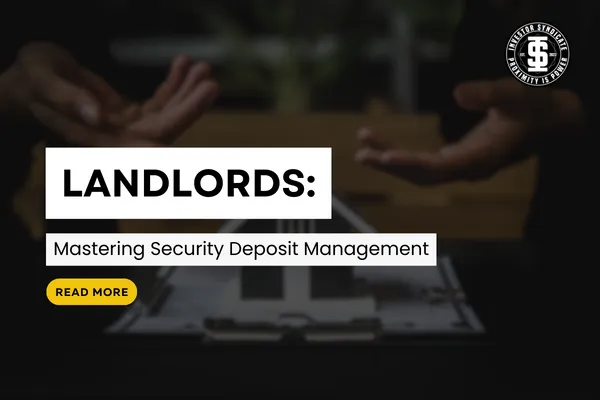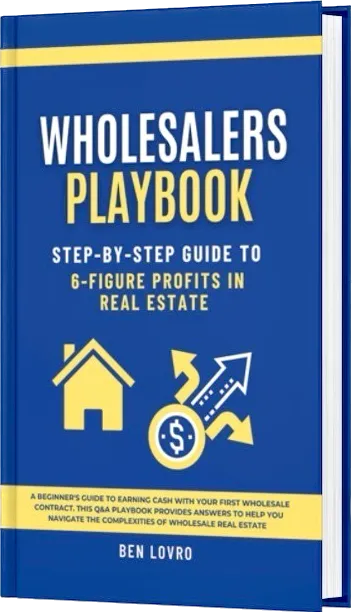Investor Syndicate Blogs
Download The Deal Flipping Playbook

Landlords: Mastering Security Deposit Management
Introduction
As landlords, handling security deposits well is really important for keeping a good relationship with your tenants and making sure your finances are secure.
Think of a security deposit like a safety net.

When a tenant moves into your property, they give you this money as a promise that they'll take care of the place.
If something gets broken or they don't pay rent, this money can cover the costs. But there are rules you need to follow.
Each state has its own laws about how much you can ask for and when you need to give the money back when they move out.
It's super important to keep this money separate from your other funds, maybe even in a special bank account.
You also need to be really clear and fair about when you use this money and how much you're taking.
If there's a disagreement, it's best to talk it out or, in tough cases, get some help to solve it. Handling security deposits right keeps everyone happy and makes your job as a landlord smoother.
Understanding Security Deposits
Security deposits are like a safety net that landlords ask for before a tenant moves into a place.
Think of it like a security blanket for the landlord.
Before a tenant starts living in a rental property, the landlord collects this money as a precaution. It's kind of like a promise from the tenant that they will take care of the property.
If something in the house gets damaged or if the tenant misses paying their rent, the landlord can use this money to fix those problems.
It's not extra rent but more like a guarantee. At the end of the rental period, if everything in the house is okay and all dues are cleared, the landlord usually gives this money back to the tenant. It’s a way to make sure that both the landlord and the tenant are protected and have peace of mind during the time of the tenancy.
Legal Regulations and Limits
It's important to know that each state in the U.S. has its own rules about these deposits.
These rules tell landlords how much they can ask for a security deposit and how quickly they need to return it when a tenant moves out.
For example, some states might say the maximum deposit is equal to one month's rent, while others might allow more.
Also, after a tenant moves out, the landlord usually has a set number of days, like 30 or 60, to give the deposit back.
If there are any damages to fix, the landlord can use part of the deposit to cover those costs.
Understanding and following these rules is really important. If landlords don’t, they could face legal problems, like having to pay fines or getting into disputes with tenants. It's all about playing by the rules to make renting a smooth experience for everyone.
Setting the Deposit Amount
When landlords ask for a security deposit, it's usually an amount that's about the same as one or two months' rent. However, this can change depending on the rules in the area where the property is located and how much the property is worth.
The idea behind the security deposit is to have a safety net for the landlord.
It's there to cover any unexpected costs, like if something gets damaged or if rent isn't paid. But it's also important for this deposit to be reasonable and fair.
It shouldn't be so high that it's impossible for tenants to afford, but it should be enough to cover any risks that come with renting out the property. This balance makes sure that the deposit is fair for both the landlord and the tenant, keeping things competitive and within the legal limits of the area.
Documenting Property Condition
Before a new tenant moves into your rental property, it's really important to do a detailed check of the property's condition.
Think of it like doing a deep investigation or going on a treasure hunt where the goal is to note down every tiny detail about the property's current state.
This process usually involves using a checklist where you mark down things like whether the paint is chipping,
if the faucets are working properly, or if there are any scratches on the floors. You basically go room by room, checking and writing down everything. It's a bit like creating a snapshot of what the property looks like at that moment.
Why do this? Well, when the tenant moves out, you can use this list to see if anything's changed or if there's any new damage.
It's a fair way to figure out if the security deposit should cover any fixes. This step is super helpful and keeps things clear and fair for both you and the tenant.
Holding Security Deposits
For landlords, handling security deposits correctly is super important, and one key rule is to keep these deposits in a separate bank account.
Think of it like this: When a tenant gives you a security deposit, it's not just extra cash for you to use.
It's more like a safety net, there to cover any damage or unpaid rent after the tenant moves out. Now, in some places, the law goes a bit further.
Not only do you need to keep this money separate, but you also have to put it in a special kind of bank account that earns interest over time. This type isn't just any account; it's called an interest-bearing account.
The cool part? Any interest the money earns while it's sitting in the bank goes back to the tenant when they move out, assuming they've kept the place in good shape and paid all their rent. This system helps keep everything fair and transparent between landlords and tenants.
Using the Deposit
As a landlord, when you collect a security deposit from your tenant, it's like having a safety net for several situations. Imagine a tenant moves out and leaves the apartment with a broken window or a huge stain on the carpet that wasn't there before. Or maybe they leave without paying the last month's rent.
In these cases, you can use the security deposit to cover these costs. It's important to remember that the deposit isn't for small, normal things that wear out over time, like a slightly faded paint. If you do need to use some of the deposit money, it's really important to make a detailed list of what you used it for – like $50 for a new window or $100 for deep cleaning.
This list, often called an itemized list of deductions, should be given to the tenant, so they know exactly what the money was used for. This keeps everything clear and fair.
Returning Deposits
As a landlord, it's really important to know about returning security deposits to your tenants. After a tenant moves out, you usually have between 14 to 60 days to give back their security deposit. This time frame can be different depending on where you live, as each state has its own rules. Use some of that money for repairs or unpaid rent, you can't just keep it without explaining.
You should provide a detailed list, called an itemized statement, that clearly shows why you're keeping part of the deposit. This list might include things like the cost of fixing a broken window or cleaning fees. This way, your tenant understands exactly what the money was used for. It's all about being clear and fair, so there are no misunderstandings between you and your tenant about the security deposit.
Dispute Resolution
When it comes to managing security deposits as a landlord, sometimes disagreements can happen with your tenants about how much of the deposit should be returned. This is called a dispute. To resolve these disputes, the first step is to talk openly and calmly with your tenant. Clear communication can often solve the issue without needing to involve anyone else.
But if talking doesn't work, you might consider mediation. This is where a neutral third person, called a mediator, helps both of you discuss the problem and find a solution that works for everyone. If mediation doesn't resolve the dispute, the last option could be going to a small claims court, where a judge will decide.
It's important to have all your documents and records in order, like the property inspection reports and any communication with the tenant. This way, you're prepared to show exactly why you made deductions from the deposit, if you did. Remember, knowing and following the law about security deposits in your state is super important in these situations.
Best Practices for Landlords
Understand and follow state laws.
Document everything related to the security deposit.
Conduct thorough property inspections before and after tenancy.
Communicate clearly and professionally with tenants.
Return the deposit promptly, with an itemized statement if deductions are made.
Conclusion
Effective management of security deposits is a crucial aspect of being a successful landlord. By adhering to legal guidelines, maintaining clear documentation, and handling tenant relationships with professionalism, landlords can navigate the intricacies of security deposit management smoothly.
Contact Us

Bet On Yourself
Empowering real estate investors with the tools they need to scale.






